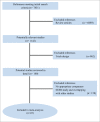A systematic review and meta-analysis of randomized trials on the role of targeted therapy in the management of advanced gastric cancer: Evidence does not translate?
- PMID: 26061272
- PMCID: PMC4623405
- DOI: 10.1080/15384047.2015.1056415
A systematic review and meta-analysis of randomized trials on the role of targeted therapy in the management of advanced gastric cancer: Evidence does not translate?
Abstract
It is still uncertain if targeted therapy-based regimens in advanced gastric cancer actually produce survival benefit. To shed light on this important question, we performed a systematic review and meta-analyses on each relevant targeted-pathway. By searching literature databases and proceedings of major cancer meetings in the time-frame 2005-2014, 22 randomized clinical trials exploring targeted therapy for a total of 7022 advanced gastric cancer patients were selected and included in the final analysis. Benefit was demonstrated for antiangiogenic agents in terms of overall survival (HR 0.759; 95%CI 0.655-0.880; p < 0.001). Conversely no benefit was found for EGFR pathway (HR 1.077; 95%CI 0.847-1.370; p = 0.543). Meta-analysis of HER-2 pathway confirmed improvement in terms of survival outcome, already known for this class of drugs (HR 0.823; 95%CI 0.722-0.939; p = 0.004). Pooled analysis demonstrated a significant survival benefit (OS: HR 0.823; PFS: HR 0.762) with acceptable tolerability profile for targeted-based therapies as compared to conventional treatments. This finding conflicts with the outcome of most individual studies, probably due to poor trial design or patients selection. In conclusion, our findings demonstrate a significant survival benefit for targeted therapy in its whole, which can be ascribed to anti-angiogenic and anti-HER2 agents.
Keywords: ADME, absorption, distribution, metabolism, and excretion; Ab, monoclonal antibody; BSC, best supportive care; CHT, chemotherapy; EGFR, epidermal growth factor receptor; GC, gastric cancer; HER2, human epidermal growth factor receptor 2; HER3, human epidermal growth factor receptor 3; MET, mesenchymal epithelial transition factor; NGS, next generation sequencing; NSCLC, non-small cell lung cancer; OR, odds-ratio; OS, overall survival; PARP, poly ADP ribose polymerase; PFS, progression free survival; PI3K, phosphatidylinositide 3-kinases; PRISMA, preferred reporting items for systematic reviews and meta-analyses; RAF, rapidly accelerated fibrosarcoma; RAS, rat sarcoma viral oncogene homolog; RCTs, randomized clinical trials; RR, response rate; TKI, tyrosine kinase inhibitor; VEGF, vascular endothelial growth factor; VEGFR: VEGF receptor; aGC, advanced gastric cancer; angiogenesis; gastric cancer; mTOR, mammalian target of rapamycin; mTORC, mTOR complex; meta-analysis; randomized clinical trials; systemic chemotherapy; targeted pathways; targeted therapy.
Figures




References
-
- Ferlay J, Shin HR, Bray F, Forman D, Mathers C, Parkin DM. Estimates of worldwide burden of cancer in 2008: GLOBOCAN 2008. Int J Cancer 2010; 127:2893-917; PMID:21351269; http://dx.doi.org/10.1002/ijc.25516 - DOI - PubMed
-
- Lauren P. The two histological main types of gastric carcinoma: Diffuse and so-called intestinal-type carcinoma. An attempt at a histo-clinical classification. Acta Pathol Microbiol Scand 1965; 64:31-49; PMID:14320675 - PubMed
-
- Shah MA, Khanin R, Tang L, Janjigian YY, Klimstra DS, Gerdes H, Kelsen DP. Molecular classification of gastric cancer: a new paradigm. Clin Cancer Res 2011; 17:2693-701; PMID:21430069; http://dx.doi.org/10.1158/1078-0432.CCR-10-2203 - DOI - PMC - PubMed
-
- Fiocca R, Luinetti O, Villani L, Mastracci L, Quilici P, Grillo F, Ranzani GN. Molecular mechanisms involved in the pathogenesis of gastric carcinoma: interactions between genetic alterations, cellular phenotype and cancer histotype. Hepatogastroenterology 2001; 48:1523-30; PMID:11813565 - PubMed
Publication types
MeSH terms
Substances
LinkOut - more resources
Full Text Sources
Other Literature Sources
Medical
Research Materials
Miscellaneous
